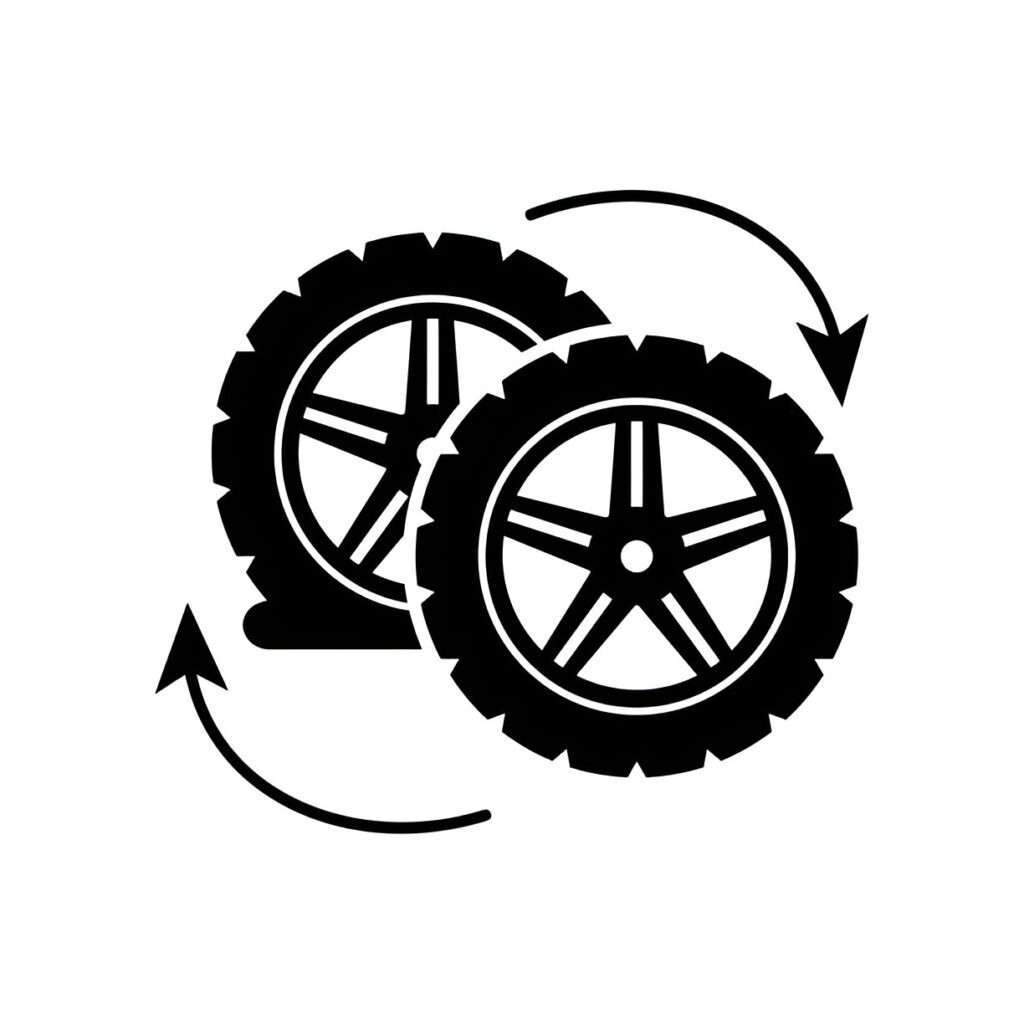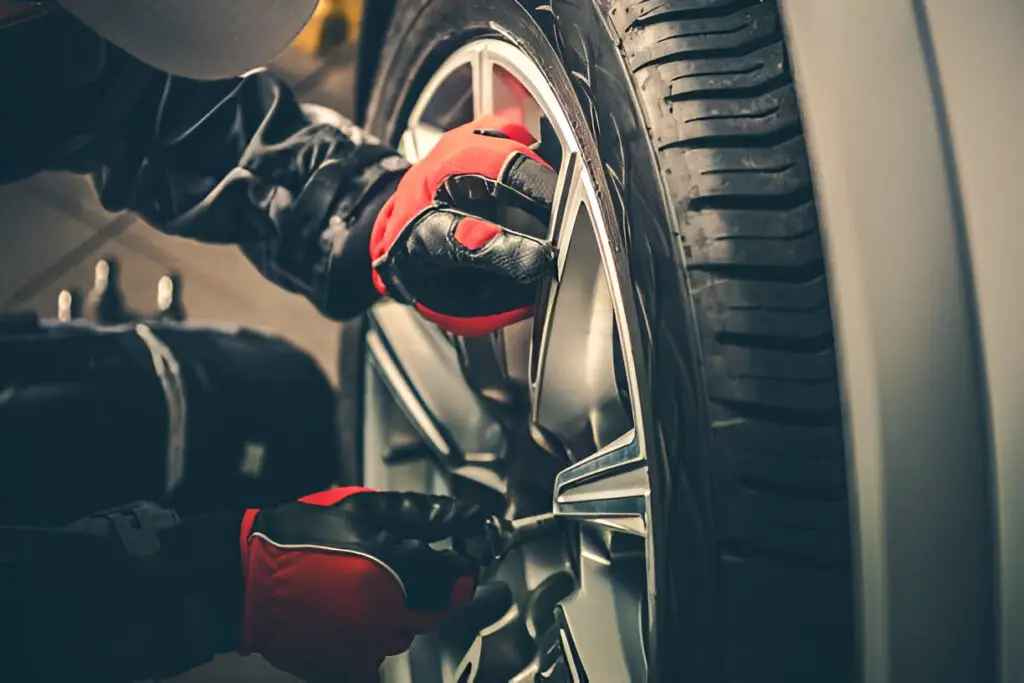Tires should typically be rotated every 5,000 to 7,500 miles, though this can vary based on vehicle type, driving habits, and tire type. Regular rotation ensures even wear, extends tire life, and improves overall vehicle performance.
Tire maintenance is essential for ensuring optimal vehicle performance and safety. One of the key aspects of tire care is rotation, a process that involves moving your vehicle’s tires from one position to another, typically from front to back or side to side. Regular tire rotations help ensure even wear and tear, extend the life of your tires, and improve fuel efficiency.
In this blog post, we’ll dive deep into the science and reasoning behind tire rotation, explore recommended intervals for various vehicles, and discuss the overall benefits of this maintenance practice. Additionally, we’ll answer five frequently asked questions about tire rotations.

Contents
Why Tire Rotation is Important?
Tires do not wear evenly due to various factors, including vehicle design, driving habits, road conditions, and tire type. The front and rear tires are subjected to different levels of stress and friction. In vehicles with front-wheel drive (FWD), the front tires bear the brunt of the workload, while in rear-wheel drive (RWD) or all-wheel drive (AWD) vehicles, the distribution is different. This uneven wear can affect handling, fuel efficiency, and safety.
By rotating your tires regularly, you can:
- Promote Even Wear: Tire rotation ensures that no single tire wears out faster than the others.
- Improve Vehicle Handling: Unevenly worn tires can reduce your vehicle’s performance in terms of handling, braking, and cornering.
- Extend Tire Life: Rotating tires helps them wear more uniformly, which can lengthen their lifespan.
- Enhance Safety: Tires that are unevenly worn may result in decreased grip on the road, particularly in poor weather conditions, posing a safety risk.
- Maintain Fuel Efficiency: Unevenly worn tires can increase rolling resistance, leading to decreased fuel efficiency.
How Often Should You Rotate Tires?
A general recommendation for tire rotation is every 5,000 to 7,500 miles (8,000 to 12,000 kilometers). However, several factors can influence how often you should rotate your tires, including your vehicle type, driving conditions, and the type of tires on your vehicle.
1. Manufacturer’s Recommendations
Vehicle manufacturers provide specific guidelines on tire rotation intervals in the owner’s manual. These guidelines are designed to optimize tire performance for that particular make and model. It’s best to follow these recommendations for accurate and safe results. Typically, manufacturers suggest tire rotations every 6,000 to 8,000 miles.
For example:
- Toyota Camry: Toyota suggests rotating the tires every 5,000 miles.
- Honda CR-V: Honda recommends rotating tires every 7,500 miles.
2. Tire Type
Different types of tires wear at different rates:
- All-Season Tires: These tires are designed for a smooth, year-round ride and tend to wear evenly over time. They should be rotated every 5,000 to 7,500 miles.
- Performance Tires: Performance tires, often found on sports cars, may wear faster and need more frequent rotations, sometimes as often as every 3,000 to 5,000 miles.
- Winter Tires: Since winter tires are typically used seasonally, you should rotate them before and after the winter season to ensure balanced wear during their usage.
3. Drive Type (FWD, RWD, AWD)
- Front-Wheel Drive (FWD): In FWD vehicles, the front tires handle most of the vehicle’s power and steering, leading to faster wear. Rotate every 5,000 to 7,500 miles.
- Rear-Wheel Drive (RWD): The rear tires in RWD vehicles bear the acceleration load, while the front tires handle the steering. This can cause different wear patterns, so rotate every 6,000 to 8,000 miles.
- All-Wheel Drive (AWD): AWD systems distribute power to all four wheels, but the front tires still often wear faster. Rotation is typically recommended every 5,000 to 7,500 miles.
4. Driving Conditions
- City Driving: Stop-and-go traffic can wear tires more quickly, especially the front ones, since they handle more braking and steering. More frequent rotations, around every 5,000 miles, may be necessary.
- Highway Driving: Highway driving tends to be smoother on tires, allowing for longer intervals between rotations.
- Off-Road or Harsh Conditions: If you frequently drive in off-road conditions, over rough terrain, or in extreme weather conditions, more frequent rotations are advised, every 3,000 to 5,000 miles.
5. Load and Vehicle Usage
If your vehicle regularly carries heavy loads, the tires may wear faster due to the added pressure. For vehicles that are used for towing or that carry heavy equipment, consider more frequent rotations.

Benefits of Regular Tire Rotation
Regular tire rotation is an essential part of vehicle maintenance that offers several benefits, including:
- Maximizes Tire Lifespan: Rotating your tires regularly prevents uneven wear, meaning you won’t have to replace your tires as often, saving money in the long run.
- Improves Performance: Evenly worn tires provide a smoother ride, better handling, and improved traction.
- Enhances Fuel Efficiency: Unevenly worn tires create more rolling resistance, which can lower fuel economy. Keeping tires evenly worn can help your vehicle maintain its optimal fuel efficiency.
- Improves Safety: Tires are your vehicle’s only contact point with the road, so their condition directly impacts your safety. Uneven tire wear can reduce your ability to brake quickly or handle the vehicle in wet or icy conditions.
- Reduces Stress on the Vehicle: Uneven tire wear can cause stress on the suspension and other parts of the vehicle, leading to more frequent maintenance issues.
Different Tire Rotation Patterns
There are several common rotation patterns, and the best one for your vehicle depends on whether you have directional or non-directional tires and whether your vehicle is FWD, RWD, or AWD.
1. Forward Cross Pattern: This pattern is common for FWD vehicles. The front tires move to the back, and the rear tires cross to the opposite side at the front.
2. Rearward Cross Pattern: Used for RWD and AWD vehicles, in this pattern, the rear tires move to the front, while the front tires cross to the rear.
3. X-Pattern: This is another pattern often used for FWD vehicles, where each tire moves to the opposite corner of the vehicle.
4. Side-to-Side Pattern: For vehicles with directional tires, which are designed to roll in only one direction, a simple side-to-side rotation is the best option. The tires on the left stay on the left, and the ones on the right stay on the right.
Signs That the Tires Need Rotation
Even if you follow a regular schedule for tire rotations, it’s still important to monitor the condition of your tires for signs of uneven wear or other issues. Here are some signs that indicate it may be time for a tire rotation:
- Uneven Wear Patterns: Visually inspect your tires for uneven tread wear, which could indicate that one set of tires is working harder than the others.
- Vibration While Driving: If your car starts to vibrate or shake while driving, particularly at higher speeds, it could be a sign that your tires are wearing unevenly or are out of balance.
- Decreased Fuel Efficiency: Uneven tire wear can cause increased rolling resistance, which may result in a noticeable drop in fuel economy.
- Handling Issues: If your vehicle feels like it’s pulling to one side or doesn’t handle corners as well as it used to, uneven tire wear could be the culprit.
Frequently Asked Questions
Here are some FAQs about the tire rotation –
1. Can I rotate my tires myself?
Yes, with the proper tools, you can rotate your tires yourself. You’ll need a jack, a lug wrench, and a torque wrench. It’s important to follow the correct rotation pattern for your vehicle. However, many people prefer to have tire rotations done by a professional to ensure it’s done safely and correctly.
2. How much does a tire rotation cost?
A tire rotation typically costs between $20 and $50, depending on where you go. Some tire shops may offer free rotations if you purchase your tires from them. Many auto shops also include tire rotations as part of routine maintenance services.
3. Do I need to align my tires after rotation?
Tire alignment is a separate service from tire rotation. While rotating your tires does not require an alignment, if your tires are showing uneven wear patterns, it may indicate an alignment issue. If that’s the case, you should consider getting an alignment to ensure your tires wear evenly going forward.
4. What happens if I don’t rotate my tires?
Failing to rotate your tires regularly can lead to uneven wear, which can result in poor handling, reduced traction, and lower fuel efficiency. Over time, you may also need to replace your tires sooner than expected.
5. Does tire rotation affect the warranty?
Yes, regular tire rotations are often required to maintain the validity of your tire warranty. Many manufacturers and tire brands require proof of regular rotation to honor warranties that cover defects and premature wear.
Conclusion
Tire rotation is a simple yet crucial part of vehicle maintenance that helps prolong tire life, improve vehicle performance, and enhance safety. By following the recommended intervals for tire rotation and monitoring your tires for signs of uneven wear, you can ensure your tires remain in top condition and provide the best possible performance. For optimal results, always consult your vehicle’s owner manual for specific recommendations, and when in doubt, seek professional advice.